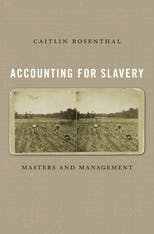
Book Review
Accounting for Slavery: Masters and Management, 2018
By Caitlin Rosenthal
This short volume contributes to a growing literature in the new history of capitalism. Rosenthal brings interesting questions to the attention of historians across a number of sub-fields. The approach is a combination of strong archival research with a tendency to broad generalisations – breadth at the expense of depth. Overall, the analysis provides a starting point for deeper immersion into the study of slavery.
After an introductory chapter, Rosenthal frames her examination of slavery around broad themes of management, capitalism, and accounting. She utilises records of plantations of the West Indies and the USA supported by a rich use of secondary sources. The lack of bibliography is a limitation for the reader to assess these sources and the extent of their use; instead, the interested reader must comb through the endnotes to determine the level of the author’s engagement with the sources. As an overview of the topic, especially for those students who are not fond of reading academic studies, it provides a useful reference.
The analysis suffers from lack of precision, for example, with respect to the definition of capitalism and the treatment and understanding of accounting. She relates her analysis to the nature of capitalism, with a sense that the link between slavery and capitalism – and similarly slavery and accounting – has rarely surfaced. She leaves some of the contrary evidence to endnotes, and does not engage with it directly to analyse her sources. For example, she states her hesitancy to use the term ‘capitalism’ as it ‘can cause confusion’ then proceeds to offer her ‘own preferred definition’ in a rather theoretical way. The definition of capitalism as an accumulation process that hinges on the commodification of labour would seem rather less than revelatory as it is ‘an article of faith’ for Marxists and non-Marxists alike. (Maddison, 2008, DOI: 10.1017/S002085900800343X)
Given the title, Accounting for Slavery, it would not be naïve to anticipate a deep immersion with the accounting literature. Again, a few endnotes point to a small number of articles; their respective arguments are not examined. Yet an engaged understanding of the accounting historiography might have informed the analysis and mitigated arguments about the nature of accounting. Indeed, the classification of some of the cited research as ‘critical accounting’ is at odds with their grounding in economics and agency theory. The arguments presented come across as novel, yet are longstanding in the accounting literature. Moreover, when Rosenthal claims that accounting ‘thrived’ due to slavery, (120), it reflects a tendency to read about accounting via those who also have been criticised for overreach (e.g. Poovey, Soll). It is not obvious what is meant by accounting ‘thriving’ although it seems to be wrapped up in issues of control and power. These concepts are not new to accounting research neither is the view that accounting creates the reality that it seeks to account for. The arguments advanced in Accounting for Slaverycould be tied more analytically to the available evidence.
Rosenthal discusses double-entry bookkeeping (DEB) at various junctures in the book. She again overlooks the rich literature in accounting over the last several decades, dismissing it with a comment on its being overly focussed on ‘striking a balance’. Regardless, it is well known that such procedures might have been done rarely and infrequently. More fundamentally, the interpretation of DEB misinterprets its nature; much of what she describes would not necessitate such a system, at least for the rationale advanced.
Related to this discussion is the presentation of depreciation, defined in terms of present-day concepts. The accounting for ‘wear and tear’ has been a feature of bookkeeping for much longer than suggested, for example, it is inherent in systems of venture accounting. Rosenthal ties this material to issues of human capital – an interesting analysis that deserves more development. She relies on a few examples of why ‘human capital’ increased and decreased in estimation, yet ties it to profit – without defining what profit meant at this time.
This tendency to write with a tone that her evidence and arguments have been heretofore ignored by other researchers leads to a less than convincing analysis. This limitation is evident in the meshing of management and business concepts with the management of plantations. Rosenthal presents an interesting analysis of the complex structure of plantations. Where it begins to waver is the effort to link it to Chandler’s M-form, with the view that what Chandler had shown for one point in time, she has pushed back to an earlier period. The argument that plantations were a preview of the multidivisional firm neglects much of the history of the early-modern era and the complex management structures of chartered firms and other trading enterprises. While a nod is given to these organisations in an endnote, it is the Hudson’s Bay Company that is referenced, the smallest of the English chartered firms. The knowledge transmission which she discusses crossed the Atlantic (and globally) in multi-lateral directions, built on a long history of enterprise exemplified by, amongst others, the Dutch VOC and the English East India Company. A discussion of ‘scientific management’ suffers from the same weakness. It rather reads history backwards.
The historical context in Accounting for Slavery could be stronger. We have little sense of global events and economics that affected slavery and the slave trade. We learn little of the nature of networks of trade and credit. While not Rosenthal’s focus, these elements emerge usefully in the final stages (instead of framing the context more fully) in the chapter on ‘managing freedom’. These caveats aside, Rosenthal’s volume provides a good starting point for those seeking an entrée into the new history of capitalism and the legacy of slavery.
Cheryl Susan McWatters
University of Ottawa